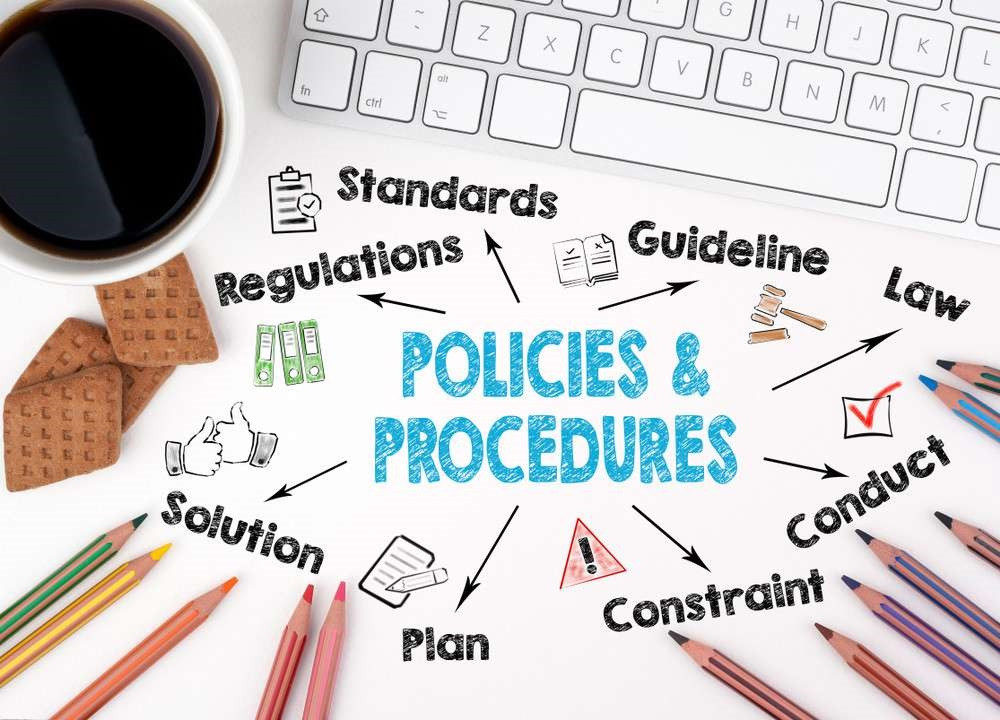Health and Safety Policies
A written Occupational Health and Safety policy (OHS) helps to promote an effective workplace OHS programme.
A company health and safety policy is a written document of a company’s goals and commitment to workplace health and safety and addresses the health and safety needs of a company. A good policy suggests how the company protects those who may be affected by hazards, risks or activities in their work environment and how those issues may be dealt with.
Why must organizations define and have a Health and Safety Policy
Health and safety policies and procedures are crucial for the workplace because they:
Show that the employer is committed to working within a set of health and safety principles.
Establish that the employer is addressing its health and safety obligations.
Clarifies the functions and responsibilities about the organisation.
Ensure that every incident is recorded, communicated to employees and implemented in a consistent and constant way.
Guide the actions of employees in a formal way.
Helps manage employees more effectively by defining acceptable and unacceptable behaviour in the workplace.
Save time by allowing health and safety matters to be handled quickly through an existing procedure, rather than staff dealing with problems as they occur or responding differently each time the same issues arise.
Each of these benefits listed above works towards improving the health and safety system within the organization to create a culture where health and safety is a commitment made by employees.
What does a Health and Safety Policy look like?
The Occupational Health and Safety Act 85 of 1993 is an all-inclusive document that can seem incredibly overwhelming. It is filled with detailed checklists and pages upon pages of rules. A well-structured policy should include the following:
A short description about the organisation
The need for OHS Compliance in the workplace with reference to the Occupational Health and Safety Act (85 of 1993)
State the rights and responsibilities of employers and employees in ensuring a safe and healthy workplace
Specifies that management is accountable for occupational health and safety programmes and their commitment to providing a safe and healthy workplace by minimizing risks and hazards
The company’s health and safety statement
The date of the policy
CEOs signature
Review date of the policy
Most companies set out their policy into 3 main sections:
Your general policy statement which explains the company commitments to effectively managing health and safety in the workplace.
Clearly set out responsibilities of the employer and employees
The details of what your aims and goals are with regards to health and safety
What is the Occupational Health and Safety Act (85 of 1993)
The Occupational Health and Safety Act 85 of 1993 is a self-regulatory act, due to the fact that it would be very difficult for the Department of Employment and Labour to police and enforce the Act at all the different organisations in our country, the law makes it the duty of both employers and employees to take responsibility for health and safety issues in their own workplace. This is what the term “self- regulatory” means.
According to section 8 of the OHS Act: General duties of employers to their employees:
Every employer shall provide and maintain, as far as reasonably practicable, a working environment that is safe and without risk to the health of his employees.
Without derogating from the generality of an employer’s duties under subsection (1), the matters to which those duties refer include in particular -
The provision and maintenance of systems of work, plant and machinery that, as far as is reasonably practicable, are safe and without risk to health;
Taking such steps as may be reasonably practicable to eliminate or mitigate any hazard or potential hazard to the safety or health of employees, before resorting to personal protective equipment;
Making arrangements for ensuring, as far as reasonably practicable, the safety and absence of risks to health in connection with the production, processing, use, handling, storage or transport of articles or substances;
Establishing, as far as is reasonably practicable, what hazards to the health or safety of persons are attached to any work which is performed, and article or substance which is produced, processed, used, handled, stored or transported and any plant or machinery which is used in his business, and he shall as far as is reasonably practicable, further establish what precautionary measures should be taken with respect to such work, article, substance, plant or machinery in order to protect the health and safety of persons, and he shall provide the necessary means to apply such precautionary measures;
Providing such information, instructions, training and supervision as may be necessary to ensure, as far as is reasonably practicable, the health and safety at work of his employees;
As far as is reasonably practicable, not permitting any employee to do any work or to produce, process, use, handle, store or transport any article or substance or to operate any plant or machinery, unless the precautionary measures contemplated in paragraphs (b) and (d), or any other precautionary measures which may be prescribed, have been taken;
Health and safety is not only the duty of employers, employees play a big role in ensuring that their workplace and fellow employees are healthy and safe. According to section 14 of the Occupational Health and Safety Act 85of 1993, employees have a list of tasks and duties too. Employees must take precautions over their own health and safety at work too, to reduce accidents, incidents and possible fatalities in the workplace. The duties are as follows:
Every employee shall at work:
Take reasonable care for the health and safety of himself and of other persons who may be affected by his acts or omissions;
As regards any duty or requirement imposed on his employer or any other person by this Act, co-operate with such employer or person to enable that duty or requirement to be performed or complied with;
Carry out any lawful order given to him, and obey the health and safety rules and procedures laid down by his employer or by anyone authorized thereto by his employer, in the interest of health or safety;
If any situation which is unsafe or unhealthy comes to his attention, as soon as practicable report such situation to his employer or to the health and safety representative for his workplace or section thereof. As the case may be, who shall report it to the employer; and
If he is involved in any incident which may affect his health or which has caused an injury to himself, report such incident to his employer or to anyone authorized thereto by the employer, or to his health and safety representative, as soon as practicable but not later than the end of the particular shift during which the incident occurred, unless the circumstances were such that the reporting of the incident was not possible, in which case he shall report the incident as soon as practicable thereafter.
MAKROSAFE have been assisting clients for more than 23 years with Health and Safety Policies, contact us now to assist you. MAKROSAFE / SAFETYWALLET / MY SAFETY SHOP are in Partnership.
MAKROSAFE / SAFETYWALLET / MY SAFETY SHOP are in Partnership.
The law achieves this self-regulation by requiring organisations to develop effective workplace policies (Section 7) and procedures.
Download your free Smoking Policy here.
The law also requires commitment from both parties (employer and employee) to ensure that these policies and procedures are applied.
According to section 7 of the OHS Act:
The chief inspector may direct:
Any employer in writing; and
Any category of employers by notice in the Gazette, to prepare a written policy concerning the protection of the health and safety of his employees at work, including a description of his organization and the arrangements for carrying out and reviewing that policy.
Any direction under subsection (1) shall be accompanied by guidelines concerning the contents of the policy concerned.
An employer shall prominently display a copy of the policy referred to in subsection (1), signed by the chief executive officer, in the workplace where his employees normally report for service.
Some very important things to recognise about the Health and Safety Act:
It sets out employers’ duties, as well as that of the employees. A safe workplace is the responsibility of the employer, such as identifying hazards, providing training, and issuing free protective clothing. Employees need to take reasonable safety precautions and report any dangerous conditions.
The Health and Safety Act applies to all workplaces. This includes all businesses and employers, including farm and domestic workers. The only exclusions are mine workers, fishing and whaling vessel employees, and those who work on floating cranes.
Health and Safety Representatives are provided for in the Act. At least one must be designated for every 100 employees.
All incidents and accidents must be recorded and these records must be kept.
The Act is enforced by inspectors, who may perform checks, searches and interviews without notice.
How to involve your employees in the Health and Safety Policy:
Engage employees in the health and safety process – this allows the employee to demonstrate commitment, ownership and develop skills. Involve employees in the health and safety planning. Send them out to departments within the organisation to learn about best practices for each department.
The method of removing a hazard starts with identifying any future hazards and reporting them timeously.
In meetings: Routinely discuss safety at employee meetings. Actively attend and partake in safety committee meetings.
Use regular feedback to encourage safe behaviors.
Launch accident investigations as soon as possible and follow up and give feedback to identify corrective actions within the organisation
Make it clear to employees that they must report if they believe conditions are hazardous or harmful.
Communicate your health and safety statement to all employees and feature it on your website or intranet. Make your health and safety policies and practices available so that it is easy for employees to consult and use.
An emergency plan should always be available and employees should be informed. It should be site-specific and based on a thorough hazard valuation.
Most injuries occur when adequate training has not been followed. Make sure that all employees have the correct training for their job descriptions.
At MAKROSAFE, we have years of experience with the Health and Safety Act, and an awesome track record to match. We will provide quality service at every stage of your Health and Safety process. Contact us today about all your organisations Health and Safety needs.
The Importance of OHS Policies in the workplace
21st Jun
Posted date: 21st Jun 2022
Latest News - Legislation - Security Industry - Educational Services Industry - Food Drinks and Tobacco Industry - Wood and Upholstery Industry - Printing and Paper Industry - Chemical Rubber Oil and Paint Industry - Iron Steel Artificial Limbs Galvanizing Garages and Metals Industry - Trade and Commerce Industry - Banking and Insurance Industry - Airline Aviation Industry - Road Transport Hauliers Industry - Entertainment and Sport Industry - Professional Services Hospitality Industry - Charitable Religion Political and Trade Organisations Industry - Glass Brick Tiles and Concrete Industry 






Comments (1)
Hi I need to supply a Health and Safety Policy and risk assesments to the DOL, being a small lodge in the Western Cape I have never been requested to provide this, can you assist with templates or recommendations. Please let me know Regards
2022-06-24 16:48:14